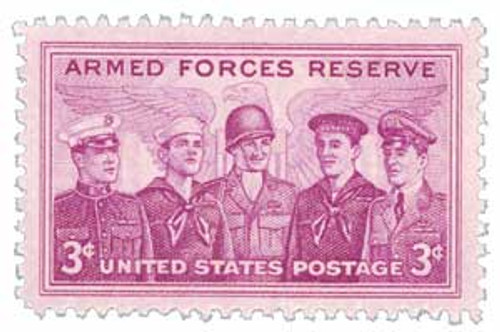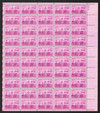
# 1067 - 1955 3¢ Armed Forces Reserve
1955 3¢ Armed Forces Reserves
City: Washington, D.C.
Quantity: 176,075,000
Printed by: Bureau of Engraving and Printing
Printing Method: Rotary Press
Perforations: 11 x 10 ½
Color: Purple
Armed Forces Day
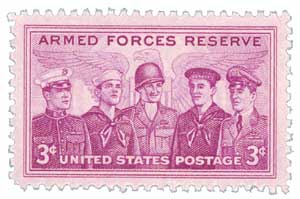
On May 20, 1950, the US first celebrated Armed Forces Day. Armed Forces Day is celebrated on the third Saturday in May, near the end of Armed Forces Week.
US Secretary of Defense Louis Johnson first introduced Armed Forces Day on August 31, 1949. The Department of Defense (DoD) had been created two years earlier to unite all of the Armed Forces into one department. The department conceived of the holiday to replace the individual days honoring each of the branches.

In the announcement of Armed Forces Day, Johnson requested each of the military leagues to stop sponsoring the individual service days and instead celebrate the unified Armed Forces Day. The Army, Navy, and Air Force agreed, but the Marine Corps League refused to end its support of Marine Corps Day. However, they would offer their support to Armed Forces Day as well.
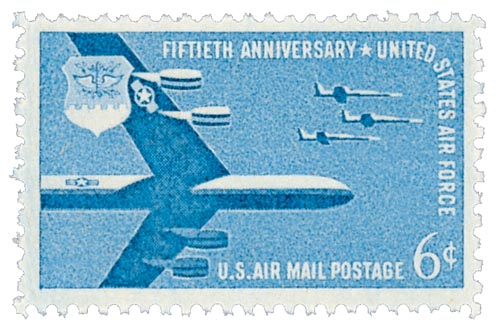
On February 27, 1950, President Harry Truman signed a Presidential Proclamation officially announcing Armed Forces Day to praise “the work of the military services at home and across the seas.” He went on to say that Armed Forces Day “marks the first combined demonstration by America’s defense team of its progress, under the National Security Act, towards the goal of readiness for any eventuality. It is the first parade of preparedness by the unified forces of our land, sea, and air defense.”
Celebrated on May 20, 1950, the first Armed Forces Day had the theme of “Teamed for Defense.” This was intended to honor the new unification of the military forces in one governmental department. The celebrations were also intended to help educate civilians on the importance of the Armed Forces and their role in civilian life. The military also used the day to show new “state-of-the-art” equipment off to the public.
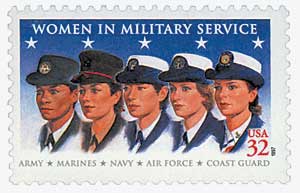
The first celebrations in 1950 included parades, open houses, receptions, and air shows. A total of 10,000 troops from all the military branches marched through Washington, DC. The celebration in New York City included 33,000 marching troops with 250 military planes flying overhead. World War II battleships visited many American harbors and several towns were treated to aerial displays. Across the nation, Americans embraced the celebrations, honoring the important role the Armed Forces played in their lives.
Over the years, Armed Forces Day has adopted different themes. These have included “Appreciation of a Nation,” “Dedication and Devotion,” “Freedom through Unity,” “Liberty,” “Patriotism,” “Power for Peace,” “Prepared to Meet the Challenge,” “Security,” and “Special Opportunity for Thanks.” Each year on Armed Forces Day, presidents, secretaries of defense, or other leaders speak out about the importance of the day. Read parts of their moving speeches below:
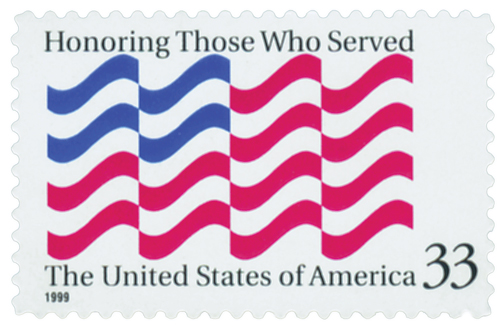
“It is fitting and proper that we devote one day each year to paying special tribute to those whose constancy and courage constitute one of the bulwarks guarding the freedom of this nation and the peace of the free world.” – President Dwight D. Eisenhower, 1953
“Close understanding between members of our Armed Forces and members of civilian communities is most important to preserve the high level of national readiness necessary for safeguarding the free world.” – General Nathan F. Twining, 1959
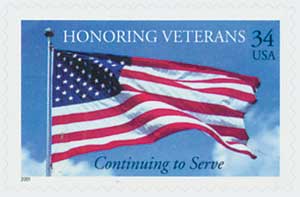
“Armed Forces Day, above all, honors the dedicated individuals who wear the uniforms of their country. Each serviceman, wherever he may be, whatever his task, contributes directly and importantly to the defense of the nation. The task of each one is the task of all the Armed Forces: to protect the freedoms which underlie the greatness of America.” – General Earle G. Wheeler, 1967
Click here for lots more stamps honoring the military.
1955 3¢ Armed Forces Reserves
City: Washington, D.C.
Quantity: 176,075,000
Printed by: Bureau of Engraving and Printing
Printing Method: Rotary Press
Perforations: 11 x 10 ½
Color: Purple
Armed Forces Day

On May 20, 1950, the US first celebrated Armed Forces Day. Armed Forces Day is celebrated on the third Saturday in May, near the end of Armed Forces Week.
US Secretary of Defense Louis Johnson first introduced Armed Forces Day on August 31, 1949. The Department of Defense (DoD) had been created two years earlier to unite all of the Armed Forces into one department. The department conceived of the holiday to replace the individual days honoring each of the branches.

In the announcement of Armed Forces Day, Johnson requested each of the military leagues to stop sponsoring the individual service days and instead celebrate the unified Armed Forces Day. The Army, Navy, and Air Force agreed, but the Marine Corps League refused to end its support of Marine Corps Day. However, they would offer their support to Armed Forces Day as well.

On February 27, 1950, President Harry Truman signed a Presidential Proclamation officially announcing Armed Forces Day to praise “the work of the military services at home and across the seas.” He went on to say that Armed Forces Day “marks the first combined demonstration by America’s defense team of its progress, under the National Security Act, towards the goal of readiness for any eventuality. It is the first parade of preparedness by the unified forces of our land, sea, and air defense.”
Celebrated on May 20, 1950, the first Armed Forces Day had the theme of “Teamed for Defense.” This was intended to honor the new unification of the military forces in one governmental department. The celebrations were also intended to help educate civilians on the importance of the Armed Forces and their role in civilian life. The military also used the day to show new “state-of-the-art” equipment off to the public.

The first celebrations in 1950 included parades, open houses, receptions, and air shows. A total of 10,000 troops from all the military branches marched through Washington, DC. The celebration in New York City included 33,000 marching troops with 250 military planes flying overhead. World War II battleships visited many American harbors and several towns were treated to aerial displays. Across the nation, Americans embraced the celebrations, honoring the important role the Armed Forces played in their lives.
Over the years, Armed Forces Day has adopted different themes. These have included “Appreciation of a Nation,” “Dedication and Devotion,” “Freedom through Unity,” “Liberty,” “Patriotism,” “Power for Peace,” “Prepared to Meet the Challenge,” “Security,” and “Special Opportunity for Thanks.” Each year on Armed Forces Day, presidents, secretaries of defense, or other leaders speak out about the importance of the day. Read parts of their moving speeches below:

“It is fitting and proper that we devote one day each year to paying special tribute to those whose constancy and courage constitute one of the bulwarks guarding the freedom of this nation and the peace of the free world.” – President Dwight D. Eisenhower, 1953
“Close understanding between members of our Armed Forces and members of civilian communities is most important to preserve the high level of national readiness necessary for safeguarding the free world.” – General Nathan F. Twining, 1959

“Armed Forces Day, above all, honors the dedicated individuals who wear the uniforms of their country. Each serviceman, wherever he may be, whatever his task, contributes directly and importantly to the defense of the nation. The task of each one is the task of all the Armed Forces: to protect the freedoms which underlie the greatness of America.” – General Earle G. Wheeler, 1967
Click here for lots more stamps honoring the military.

